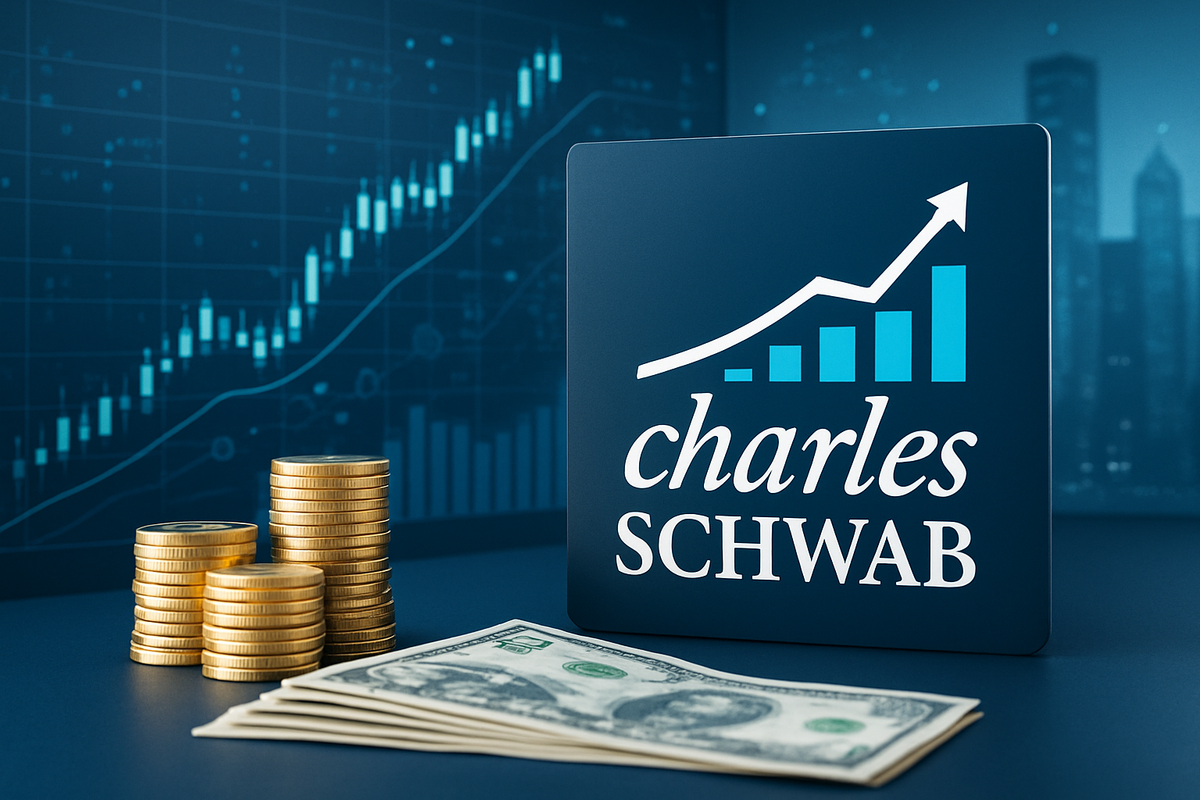
WESTLAKE, Texas – October 23, 2025 – The Charles Schwab Corporation (NYSE: SCHW) today announced a regular quarterly cash dividend of $0.27 per common share, reaffirming its commitment to shareholder returns. Concurrently, the financial services giant also declared dividends for its outstanding preferred stock series. This consistent declaration signals robust financial health and management's confidence in the company's sustained profitability and future cash flows, providing a strong sense of stability to the market.
This move comes as Charles Schwab continues to navigate a dynamic financial landscape, leveraging its diversified business model encompassing wealth management, brokerage, banking, and asset management. The dividend payout underscores the firm's ability to generate ample earnings to cover its distributions while retaining capital for strategic investments and growth, a particularly important signal for a major financial institution.
Unpacking Schwab's Latest Dividend Declaration
On October 23, 2025, The Charles Schwab Corporation's Board of Directors declared a regular quarterly cash dividend of $0.27 per common share. This common stock dividend is scheduled for payment on November 28, 2025, to stockholders of record as of November 14, 2025. In addition to the common stock payout, the Board also declared dividends on several series of its outstanding preferred stock, with a payment date of December 1, 2025, and a record date of November 14, 2025. While specific amounts for each preferred series were not detailed in the immediate announcement, previous declarations have included various series such as 5.95% Non-Cumulative Perpetual Preferred Stock, Series D, and 4.000% Fixed-Rate Reset Non-Cumulative Perpetual Preferred Stock, Series I.
This declaration is part of Schwab's long-standing policy of quarterly dividend payments, a practice it has maintained for 37 consecutive years. The common stock dividend has been consistently set at $0.27 per share in recent declarations, with the company demonstrating a one-year dividend increase. This consistency, coupled with dividend payments per share showing growth of 6.00% over the past 12 months, 9.83% over the past 36 months, and 16.01% over the past 120 months, reflects a deliberate and successful strategy of shareholder value creation.
The decision to declare these dividends was made by The Board of Directors of The Charles Schwab Corporation. Executive leadership, including Co-Chairman Walt Bettinger, often provides context for such strategic financial decisions, which are frequently accompanied by share repurchase programs aimed at optimizing capital allocation.
Initial market reactions to such declarations from Charles Schwab are typically positive, especially when underpinned by strong financial performance. The company has recently reported robust third-quarter 2025 results, with net income of $2.36 billion and significant earnings per share gains. Client assets reached record highs, and the firm continued its impressive streak of adding over one million new brokerage accounts for the fourth consecutive quarter. This sustained positive momentum and growth contribute to a generally favorable market and industry reception for continued dividend payments.
Market Dynamics: Winners and Losers in the Wake of Schwab's Dividend
Charles Schwab's (NYSE: SCHW) consistent dividend declaration on October 23, 2025, creates ripple effects throughout the financial services industry, influencing investor perceptions and competitive dynamics.
The most direct beneficiary is Charles Schwab (NYSE: SCHW) itself. A stable and declared dividend signals robust financial health, strong profitability, and effective capital management. This enhances investor confidence, attracts income-focused investors, and contributes to stock price stability. Financial institutions are particularly sensitive to dividend cuts, which can signal distress, making Schwab's steady payout a powerful affirmation of its long-term success.
Other established, financially strong dividend-paying competitors could also experience positive spillover. If Schwab's consistent dividends reinforce the perception that large, stable brokerage and wealth management firms are reliable income generators, companies like Fidelity Investments, Vanguard, Bank of America (NYSE: BAC) (Merrill Lynch), Wells Fargo Advisors (NYSE: WFC), and Raymond James Financial (NYSE: RJF) might see sustained investor interest. These firms, often compared to Schwab, could be viewed as equally attractive for their stability and shareholder returns, provided they also demonstrate strong financial health. Furthermore, companies that provide advanced technology, AI, and cybersecurity solutions to financial institutions could indirectly benefit as brokerage firms continue to invest heavily to maintain competitiveness and meet evolving client demands.
Conversely, weaker competitors or those with inconsistent dividend policies could find themselves at a disadvantage. Brokerage firms and wealth managers struggling with profitability or deposit retention, or those with erratic capital return strategies, might be negatively highlighted by Schwab's robust dividend. This could put pressure on them to demonstrate similar financial discipline or risk losing investor favor and market share. Smaller, undifferentiated players may also struggle to compete against the scale, technological investments, and consistent returns offered by giants like Schwab, potentially drawing capital away from less proven platforms. Growth-focused firms without a clear path to sustainable profitability and consistent free cash flow for dividends might also be viewed less favorably by income-seeking investors, subtly shifting preferences towards firms that balance growth with demonstrable shareholder returns.
Wider Significance in a Transforming Financial Landscape
Charles Schwab's (NYSE: SCHW) dividend declaration on October 23, 2025, holds broader significance, reflecting key industry trends, influencing competitors, and aligning with regulatory expectations.
This event fits squarely into several overarching trends in the financial services industry. Schwab's record client assets and strong net new asset inflows underscore the ongoing growth in wealth accumulation and the escalating demand for comprehensive advisory and brokerage services. Financial firms are fiercely competing to attract and retain client assets by offering integrated platforms that combine trading, banking, and wealth management. Furthermore, Schwab's robust performance, even amidst potential shifts in interest rate expectations, indicates its ability to generate revenue from diverse sources, including asset management fees and trading volumes, thereby mitigating reliance on net interest income. The brokerage industry has also witnessed significant consolidation, exemplified by Schwab's acquisition of TD Ameritrade, and intense competition from fintech challengers. Schwab's consistent dividend, therefore, highlights its successful navigation of this complex competitive environment through scale, diversified offerings, and integrated platforms.
The ripple effects on competitors are palpable. Rival brokerages and wealth management firms, such as Fidelity, E*Trade (NASDAQ: MS) (now part of Morgan Stanley), and other independent advisors, may face increased pressure to maintain competitive dividend policies to attract and retain investors. A strong dividend from Schwab signals financial health and investor confidence, potentially making competitors appear less appealing if their shareholder return policies lag. This can also give Schwab an edge in attracting both clients seeking stable financial partners and talented professionals looking for secure employment. As a major player, Schwab's financial health and dividend policy can also serve as a bellwether for the broader capital markets and financial services industry, contributing to overall positive sentiment.
From a regulatory standpoint, dividend declarations by major financial institutions are closely scrutinized. Regulators view a firm's ability to pay consistent or increasing dividends as a key indicator of its financial health, robust capital levels, and prudent risk management. This reduces concerns about potential instability within the financial system. A strong dividend payment implies that Schwab is comfortably above regulatory capital thresholds and is not facing pressure to retain capital. Historically, dividend policies have served as critical market signals; increases are generally seen as positive forecasts of performance, while cuts can signal financial distress. Banks have historically been reluctant to cut dividends due to the strong negative signal such actions send, reinforcing the importance of Schwab's consistent payout.
Navigating the Future: What Comes Next for Schwab and the Market
Following Charles Schwab's (NYSE: SCHW) dividend declaration, the company and the broader market face a landscape of both opportunities and challenges, necessitating strategic foresight and adaptability.
In the short term, Schwab is poised to reinforce investor confidence, building on its consistent dividend history and share repurchase programs. Positive market reactions are anticipated, buttressed by strong analyst ratings and price targets reflecting upside potential. However, short-term challenges persist, primarily concerning interest rate fluctuations. As a significant portion of Schwab's revenue derives from net interest margin, shifts in interest rates, while potentially driving cash inflows, could also impact net interest revenue.
Looking at the long term, Schwab's strategy centers on continued growth, deepening client relationships, and technological innovation. The successful integration of TD Ameritrade's vast client base and assets remains a key driver. Schwab plans to expand its physical presence with new branches and hire more financial consultants, while simultaneously investing heavily in digital capabilities, including AI and machine learning, to enhance client experience and operational efficiency. Diversification of offerings, particularly into managed investing solutions and the planned launch of spot crypto trading in the first half of 2026, are critical long-term growth avenues. Analyst projections for Schwab's earnings and revenue growth remain robust, signaling a strong trajectory.
Strategic pivots and adaptations are crucial for both Schwab and its competitors. Schwab's key adaptation involves diversifying revenue streams beyond its reliance on net interest income, with a greater focus on asset management fees, trading revenue, and advisory services. Adapting to potential regulatory changes, such as those affecting Payment for Order Flow (PFOF), may necessitate shifts towards subscription fees or other value-added service models. Competitors, including Fidelity, Vanguard, SoFi (NASDAQ: SOFI), Robinhood (NASDAQ: HOOD), and Interactive Brokers (NASDAQ: IBKR), are likely to mirror Schwab's focus on technological innovation, multi-asset platforms, and expanding into traditional banking services to diversify and enhance profitability.
Market opportunities abound, driven by the integration of AI and machine learning for personalized advice and automated trading, the increasing acceptance of new asset classes like cryptocurrencies, and the ongoing democratization of finance through accessible platforms. Growing investor demand for ESG (Environmental, Social, and Governance) investing and opportunities in global expansion also present significant avenues for growth. However, market challenges remain formidable, including intense competition and fee compression, evolving regulatory landscapes, interest rate sensitivity, market volatility, and persistent cybersecurity threats. Moreover, sophisticated client behavior, such as moving cash to higher-yielding instruments, can impact a brokerage's net interest income.
Potential scenarios range from an optimistic outcome of sustained growth and diversification, where Schwab successfully executes its strategic initiatives, leading to continued strong client asset growth and market share expansion. A moderate scenario envisions steady performance amidst headwinds, with Schwab maintaining its strong position but facing persistent competition and macroeconomic pressures. In a more challenging scenario, significant adverse regulatory changes or prolonged unfavorable economic conditions could severely impact Schwab's revenue model, leading to slower growth and potential market share erosion if competitors out-innovate in key digital offerings or new asset classes.
A Steady Hand in Shifting Currents: Schwab's Enduring Signal
Charles Schwab's (NYSE: SCHW) declaration of a regular quarterly cash dividend of $0.27 per common share and preferred stock dividends on October 23, 2025, serves as a powerful testament to its enduring financial strength and unwavering commitment to its shareholders. The key takeaway from this event is the reinforcement of Schwab's position as a stable and reliable investment in the financial services sector, particularly in an environment characterized by evolving market dynamics and technological advancements. This consistent payout, backed by robust third-quarter results and strategic growth initiatives, signals management's confidence in the company's sustained profitability and future cash generation capabilities.
Moving forward, the market assessment for financial services firms like Schwab remains cautiously optimistic. While Fitch Ratings projects a solid outlook for the sector, anticipating stronger profits from capital markets activity and stabilizing net interest margins, the trajectory of interest rates will be a critical determinant. Schwab's ability to maintain its dividend amidst fluctuating interest rate expectations underscores the resilience of its diversified business model, which spans wealth management, brokerage, banking, and asset management. The firm's strategic focus on balancing shareholder returns with aggressive reinvestment in growth areas, such as digital assets and AI-driven solutions, positions it for long-term relevance and competitiveness.
The significance and lasting impact of this dividend declaration lie in its role as a beacon of stability. In an industry prone to rapid change and disruption, a consistent dividend from a major player like Schwab reassures investors and sets a benchmark for competitors. It reinforces the idea that established financial institutions can successfully navigate complex economic cycles and technological shifts while continuing to reward their shareholders. This fosters trust and confidence, which are invaluable assets in the financial world.
Investors should closely watch for several key indicators in the coming months. The Federal Reserve's interest rate policy decisions and their subsequent impact on Schwab's net interest income will be paramount. Continued growth in net new assets and the successful integration of legacy Ameritrade client accounts will signal organic growth and operational efficiency. Furthermore, Schwab's progress in launching its spot crypto platform in early 2026 could be a significant growth driver, attracting new client segments. Lastly, broader economic and geopolitical factors, alongside any new regulatory developments, will continue to influence market sentiment and overall industry performance.
This content is intended for informational purposes only and is not financial advice





